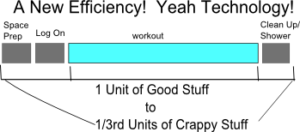- Do you need to workout at a gym to get results or can you do it at home?
- Can the latest piece of workout equipment be a high-speed internet connection instead of a $1000 machine?
- Can in-person access to a qualified personal trainer cost less than the typical $75-$100 per workout?
- Do you really need to workout for an hour at a time or can you make progress with less?
The alternative to long-form workouts are HIIT Training Workouts:
The general principle behind this type of training is that short periods of very intense exercise can have equal or greater effects on general fitness level than long periods of steady-state cardio. It has also been shown that HIIT training increases the capacity for fat oxidation.
There are a lot of runners who write for and read this blog. We are not, by any means, advocating that you stop running! Running is unquestionably a great way to improve your fitness level, meet great people, get outside, and maintain a healthy heart and lungs. But I would encourage every runner, in fact, everyone (who has been cleared by their physician) to try some form of high intensity training.
There is a technical definition of HIIT training workouts that involve certain measures of physiology. I don’t think it is necessary to get into the fine details unless you want to become an elite athlete. For almost everyone short periods of ‘sprint-like’ training will yield physiological benefits (see ‘The Benefits of HIIT” below).
Conventional wisdom says that 10-minutes is too short a time period to do much good. Workouts should be at least 30 minutes and up to 2 hours in duration. But I wonder how much of this comes from health clubs and/or organized sports.
For instance, if you run a health club your clientele must travel to the health club, get signed in, change clothes, workout, then shower, change clothes again, sign out, pay for parking and then travel home. There is a lot of transition time here, even if you are walking from work. So in this case it does seem silly to workout for anything less than 30-minutes so that your 60-minutes of traveling and preparation makes sense.


Likewise in organized sports there are a lot of people who all have to be scheduled to meet at the same place at the same time. It doesn’t make sense to do this in less than hour long chunks. In the age of technology it is often possible to access a 10 minute HIIT workout and increase the ratio of time spent working to time spent preparing.
Is ten minutes of physical activity a day enough?
No. We all need more than 10-minutes of physical activity a day.
But if 10-minutes is all you got for the day than I would argue that those first 10-minutes of working out provide a disproportionately large amount of the benefits of working-out. Getting in at least that 10-minutes a day is vitally important. It builds a habit. It gives you an incredible mood and energy boost. It prevents the significant muscular atrophy that can happen in only a few days of not working out at all. And just doing those 10-minutes starts a snowball effect, where you are inspired to be more active the rest of the day.
The first 10 minutes is as valuable as the next 20.
The Benefits of High Intensity Interval Training
*Increase Anaerobic and Aerobic Capacity
*Increased Energy
“My energy level increased tremendously” ~Nancy LeBlanc, Executive Assistant and Tennis Player
*Lightening of Mood
Not a lot of quantitative research in this area. But in our experience the world seems a lot brighter after a hiit workout. Conduct your own study. Try a workout.
Helps you fit into your drawers
*Alters Metabolism for 24-hours after the workout.

